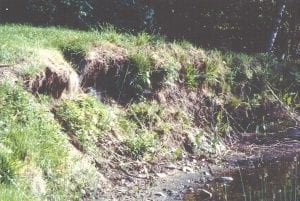Erosion affects water quality, whether it occurs next to a lake, stream or wetland or in the heart of a city housing development. Erosion is the wearing-away of soils due to open areas and scarce vegetation.
Erosion contains soil particles that are moved from one spot to another by water runoff. High concentrations of soil particles in water can adversely affect aquatic ecosystems by picking up other nutrients with the soil particles, covering spawning areas with sediment, changing light patterns and water clarity with particles suspended in the water, and making Minnesota waters generally a less desirable habitat for fish and wildlife. Many plants and animals need clean, clear water to survive — from microscopic zooplankton at the bottom of the food chain, to frogs, turtles, fish and waterfowl.
Excessive nutrients stimulate excessive plant growth. Nutrients can come from many sources. Some are found naturally in Minnesota soils.
But many nutrients come from fertilizers applied to agricultural fields, golf courses and traditional lawns.
Soil erosion not only affects water in lakes and streams, it may also reduce cropland fertility and cause agricultural drainage ditches to fill with sediment, requiring costly ditch maintenance. Some water utilities also use water from rivers and lakes as a source of local drinking water and must spend more to treat water that has high sediment concentrations from erosion.
There are two ways to prevent erosion: hard armoring and soft armoring.
Hard-armor techniques include riprap (placing large rocks up an eroding slope) or retaining walls. Hard armoring is expensive to install and is often installed incorrectly.
Increasingly popular are soft-armor methods, which use organic and inorganic materials, like swells or swales, combined with plants to create a living barrier of protection. These create a more natural, environmentally friendly barrier with the added benefit of enhancing habitat. Replacing bare spots with native plants can add color and interest to your landscape and attract a wide variety of birds, butterflies and wildlife.
TheMinnesota Department of Natural Resources (DNR) has several publications available on its Web site that can help people manage property to reduce runoff and benefit Minnesota’s native habitat. Everything we do on the land impacts our waters. Learn how to help at www.mndnr. gov.



Loading Comments